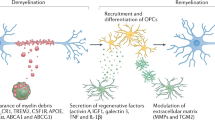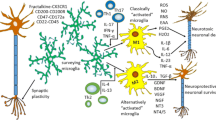Abstract
Microglia are the resident macrophages of the nervous system. They serve to protect and preserve neuronal cells from pathogens and facilitate recovery from metabolic insults. In addition, they appear to play a role in the neuropathology of noninfectious inflammatory disorders of the central nervous system, especially those that are autoimmune. Presentation of neural autoantigens to autoreactive T cells by microglia and the attendant secretion of proinflammatory cytokines are thought to facilitate the inflammatory process in diseases such as multiple sclerosis. They also serve as scavengers of damaged myelin following death of oligodendrocytes and the destruction of myelin and may, therefore, promote recovery of myelin damaged by the inflammatory insult. This review examines the current controversies on the pathology of multiple sclerosis and the role played by microglia in the development of central nervous system demyelination.
Similar content being viewed by others
References and Recommended Reading
Streit WJ, Kincaid-Colton A: The brains’s immune system. Sci Am 1995, 83:54–60.
Neumann H, Cavalie A, Jenne DE, Wekerle H: Induction of MHC class I genes in neurons. Science 1995, 269:549–552.
Streit WJ: Microglia as neuroprotective, immunocompetent cells of the CNS. Glia 2002, 40:133–139.
Nakamura Y: Regulating factors fro microglial activation. Biol Pharm Bull 2002, 25:945–953.
Aloisi F: Immune function of microglia. Glia 2001, 36:165–179.
Noseworthy JH, Lucchinetti C, Rodriguez M, Weinshenker BG: Multiple sclerosis. N Engl J Med 2000, 343:938–952.
McDonald WI, Compston A, Edan G, et al.: Recommended diagnostic criteria for multiple sclerosis: guidelines from the International Panel on the diagnosis of multiple sclerosis. Ann Neurol 2001, 50:121–127.
Lumsden CE: The immunogenesis of the MS plaque. Brain Res 1971, 28:365–371.
Carson MJ: Microglia as liaisons between the immune and central nervous systems: functional implications for multiple sclerosis. Glia 2002, 40:218–231.
Benveniste EN: Role of macrophages/microglia in multiple sclerosis and experimental allergic encephalomyelitis. J Mol Med 1997, 75:165–173.
Perry VH, Gordon S: Macrophages and the nervous system. Int Rev Cytol 1991, 125:203–244.
Rio-Hortega D: Microglia, vol 2. Edited by Penfield W. New York: Paul B. Hoecker; 1932.
Hickey W, Kimura H: Perivascular microglial cells of the CNS are bone marrow derived and present antigen in vivo. Science 1988, 239:290–293.
Cuadros MA, Navascues J: The origin and differentiation of microglial cells during development. Prog Neurobiol 1998, 56:173–189.
Ling EA: The ontogeny of microglial cells. Adv Cell Neurobiol 1981, 2:32–82.
Guillemin GJ, Brew BJ: Microglia, macrophages, perivascular macrophages, and pericytes: a review of function and identification. J Leukocyte Biol 2004, 75:388–397.
Rock RB, Gekker G, Hu S, et al.: Role of microglia in central nervous system infections. Clin Microbiol Rev 2004, 17:942–964.
Nelson PT, Soma LA, Lavi E: Microglia in diseases of the central nervous system. Ann Med 2002, 34:491–500.
Ulvestad E, Williams K, Bjerkvig R, et al.: Human microglial cells have phenotypic and functional characteristics in common with both macrophages and dendritic antigenpresenting cells. J Leukocyte Biol 1994, 56:732–740.
Nguyen MD, Julien JP, Rivest S: Innate immunity: the missing link in neuroprotection and neurodegeneration? Nat Rev Neurosci 2002, 3:216–227.
Toft-Hansen H, Nuttall RK, Edwards DR, Owens T: Key metalloproteinases are expressed by specific cell types in experimental autoimmune encephalomyelitis. J Immunol 2004, 173:5209–5218.
John GR, Lee SC, Brosnan CF: Cytokines; powerful regulators of glial cell activation. Neuroscientist 2003, 9:10–22.
Raine CS: Multiple sclerosis: immunopathological mechanisms in the progression and resolution of inflammatory demyelination. Res Publ Assoc Res Nerv Ment Dis 1990, 68:37–54.
Lucchinetti C, Bruck W, Parisi J, et al.: Heterogeneity of multiple sclerosis lesions: implications for the pathogenesis of demyelination. Ann Neurol 2000, 47:707–717. A comprehensive description on the heterogeneity of demyelinating lesions in MS. This paper also suggests that the demyelinating lesions are similar within each patient.
Prineas JW: Pathlogy of multiple sclerosis. In Handbook of Multiple Sclerosis. Edited by Cook S. New York: Marcel Dekker; 1990:187–215.
Hartung HP, Grossman RI: ADEM: distinct disease or part of the MS spectrum? Neurology 2001, 56:1257–1260.
Dale RC: Acute disseminated encephalomyelitis. Semin Pediatr Infect Dis 2003, 14:90–95.
Martin R, McFarland HF, McFarlin DE: Immunology of demyelinating disease. Ann Rev Immunol 1992, 10:153–169.
Mcfarlin DE, Mcfarland HF: Multiple Sclerosis. N Engl J Med 1982, 307:1183–1188.
Zamvil SS, Steinman LS: The T lymphocyte in experimental allergic encephalomyelitis. Annu Rev Immunol 1990, 8:579–621.
Genain CP, Nguyen MH, Letvin NL, et al.: Antibody facilitation of multiple sclerosis-like lesions in a nonhuman primate. J Clin Invest 1995, 96:2966–2974.
Linington C, Berger T, Perry L, et al.: T cells specific for the myelin oligodendrocyte glycoprotein mediate an unusual autoimmune inflammatory response in the central nervous system. Eur J Immunol 1993, 23:1364–1372.
Iglesias A, Bauer J, Litzenburger T, et al.: T- and B-cell responses to myelin oligodendrocyte glycoprotein in experimental autoimmune encephalomyelitis and multiple sclerosis. Glia 2001, 36:220–234. A comprehensive review of MOG-EAE and its relevance to MS.
Chiang CS, Powell HC, Gold LH, et al.: Macrophage/microglial mediated primary demyelination and motor disease induced by the CNS production of IL-3 in transgenic mice. J Clin Invest 1996, 97:1512–1524.
Owens T, Wekerle H, Antel J: Genetic models of CNS inflammation. Nat Med 2001, 7:161–166. An elegant review that summarizes the relevance of transgenic models of CNS demyelination to human MS.
Owens T: The enigma of multiple sclerosis: inflammation and neurodegeneration cause heterogeneous dysfunction and damage. Curr Opin Neurol 2003, 16:259–265.
Selmaj KW, Raine CS: TNF alpha myelin and oligodendrocyte injury in vitro. Ann Neurol 1989, 23:339–345.
Sriram S, Rodriguez M: Indictment of the microglia as the villain in multiple sclerosis. Neurology 1997, 48:464–470.
Olson JK, Miller SD: Microglia initiate central nervous system innate and adaptive immune responses through multiple TLRs. J Immunol 2004, 173:3916–3924. This paper recognizes the role played by Toll-like receptors in the development of innate immunity within the CNS.
Rivest S: Molecular insights on the cerebral innate immune system. Brain Behav Immunol 2003, 17:13–19.
Budka H: Neuropathology of human immunodeficiency virus infection. Brain Pathol 1991, 1:163–175.
Barnett MH, Prineas JW: Relapsing and remitting multiple sclerosis: pathology of the newly forming lesion. Ann Neurol 2004, 55:458–468. An important paper that challenges the current views on the role of autoimmunity in MS. The authors also show that destruction of oligodendrocyte as the major and primary event in MS.
McGeer PL, Kawamata T, Walker DG, et al.: Microglia in degenerative neurological disease. Glia 1993, 7:84–92.
Henson PM, Bratton DL, Fadok VA: The phosphatidylserine receptor: a crucial molecular switch? Nat Rev Mol Cell Biol 2001, 2:627–633.
Fadok VA, Bratton DL, Henson PM: Phagocyte receptors for apoptotic cells: recognition, uptake, and consequences. J Clin Invest 2001, 108:957–962.
Bo L, Vedeler CA, Nyland HI, et al.: Subpial demyelination in the cerebral cortex of multiple sclerosis patients. J Neuropathol Exp Neurol 2003, 62:723–732.
Bo L, Vedeler CA, Nyland H, et al.: Intracortical multiple sclerosis lesions are not associated with increased lymphocyte infiltration. Mult Scler 2003, 9:323–331. This paper shows the lack of inflammation in cortical areas undergoing demyelination and suggests that inflammation is not a major component in cortical regions of the brain.
Author information
Authors and Affiliations
Rights and permissions
About this article
Cite this article
Deng, X., Sriram, S. Role of microglia in multiple sclerosis. Curr Neurol Neurosci Rep 5, 239–244 (2005). https://doi.org/10.1007/s11910-005-0052-x
Issue Date:
DOI: https://doi.org/10.1007/s11910-005-0052-x




